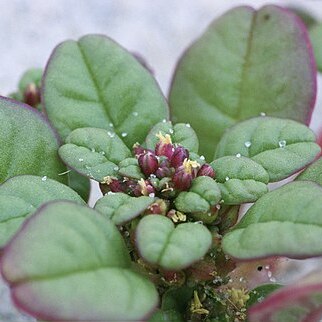Monoecious; stems fleshy, prostrate or decumbent, branched from the base, 1–4 dm; lvs fleshy, round-obovate, 1–2 cm, ± retuse at the broadly rounded summit, abruptly narrowed to a 5–10 mm petiole; fls in dense axillary clusters; stamens 5; sep of pistillate fls 5, oblong-oblanceolate, unequal, cucullate, 2–4 mm, twice as long as the lanceolate bracts; fr fleshy, indehiscent, thick-fusiform, 4–5 mm, smooth or rugulose; seed elliptic, 2–2.5 mm. Sea-beaches; Mass. to N.C.; rare.
A herb with stems that lie along the ground. It can form mats. They are red and 10-40 cm long. The leaves are fleshy and clustered near the ends of the branches. They are broadly oval and 1-1.5 cm long. The flowers are yellow. The seeds are reddish brown and 2.5 mm across. They are shiny.

